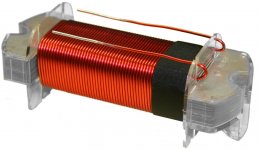Hi everybody.
I have an iron core inductor that currently has a value of 1.8 mh.
I need to change it to 3 mh. The supplier has none in stock and the part would be back ordered til who knows when.
Would it be possible to change the value of this by adding windings or would I be better off to buy another?
I have a DATS v3, so I can test and fine tune.
If this is something anybody has done please tell me what and how.
Thanks!
I have an iron core inductor that currently has a value of 1.8 mh.
I need to change it to 3 mh. The supplier has none in stock and the part would be back ordered til who knows when.
Would it be possible to change the value of this by adding windings or would I be better off to buy another?
I have a DATS v3, so I can test and fine tune.
If this is something anybody has done please tell me what and how.
Thanks!
Attachments
Just buy a larger value like 3.3mH or so and unwind it if you feel the need. But first, try the 3.3mH, maybe it's good enough and don't need to be exact 3mH.
Just buy a larger value like 3.3mH or so and unwind it if you feel the need. But first, try the 3.3mH, maybe it's good enough and don't need to be exact 3mH.
OK, thanks. That's doable. They do have one in stock.
But I have to ask, has anyone done this? Increased the value of an inductor by adding windings?
But I have to ask, has anyone done this? Increased the value of an inductor by adding windings?
Absolutely. But @YSDR's advice is spot on.
Yes, it would take just less than a third more to get to 3mH.has anyone done this? Increased the value of an inductor by adding windings?
Yes, it would take just less than a third more to get to 3mH.
Thanks Allen.
If there's room, wouldn't it be easier to add a 1.2 mh inductor in series?
Thanks mboxler.
I was more curious if anybody's done it and how.
It's a massive piece, just over 4" x ~2" and my PC boards are just big enough to fit it and the caps. I suppose I could make room for another inductor if I do a little drilling.
If there's room, wouldn't it be easier to add a 1.2 mh inductor in series?
I think that's not the most optimal choice due to the increased chance of coil interaction. But if there is room to place far away enough from other coils...
GordB,
it would neither be smart to buy a new larger inductance coil nor add another in series with this one. Just solder some magnet wire to your current inductor and constantly check its inductance, once you have it, cut the rest and finish it. Space you've got plenty.
it would neither be smart to buy a new larger inductance coil nor add another in series with this one. Just solder some magnet wire to your current inductor and constantly check its inductance, once you have it, cut the rest and finish it. Space you've got plenty.
Last edited:
GordB,
it would neither be smart to buy a new larger inductance coil nor add another in series with this one. Just solder some magnet wire to your current inductor and constantly check its inductance, once you have it, cut the rest and finish it. Space you've got plenty.
Thanks Lojzek.
We can help you calculate approx. additional wire length to arrive at 3mH, if you need it.
edit: is this Erse Audio ESQ55-16-1800 that you have, 16awg, SuperQ?
edit: is this Erse Audio ESQ55-16-1800 that you have, 16awg, SuperQ?
Last edited:
According to my calculations, you'd need about 3.7 m of magnet wire to make it become 3mH.
Killer. I've ordered a 4 oz spool which is almost 10m. Should be good.
Now, does the joint between the existing and new magnet wire, once soldered, need to be insulated? And could a guy use something like nail polish for the insulation or just use shrink tubing?
It does not need to be, but you could if you felt up for it. I never did. If it measures the right mH, it is fine, and if something went wrong, you'd measure it as such. Make the soldered spot nice and well done and you will be alright. A couple of mm of overlap should suffice.
OK good.
I'll take a bunch of pictures while I'm doing it and post them up in case anyone else is interested in this type of modification.
I'll take a bunch of pictures while I'm doing it and post them up in case anyone else is interested in this type of modification.
The joint is probably going to be fat and have sharp edges. I would use lengthwise twisting (before soldering) and heatshrink to prevent damaging other insulation, and preferrably have it off to one end.
The joint is probably going to be fat and have sharp edges. I would use lengthwise twisting (before soldering) and heatshrink to prevent damaging other insulation, and preferrably have it off to one end.
Thanks Allen.
I'll see if I can make that happen. It looks like the core, which is rectangular, is about 31 mm on a side, and 40 or so on the other. I'll try to get it lined up on the longer of the two.
- Home
- Loudspeakers
- Multi-Way
- Inductor value
